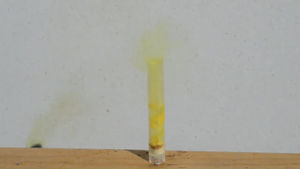Chlorine dioxide

| |
| Names | |
|---|---|
| IUPAC name
Chlorine dioxide
| |
| Preferred IUPAC name
Chlorine dioxide | |
| Systematic IUPAC name
Chlorine dioxide | |
| Other names
Chlorine(IV) oxide
Chlorine peroxide Chloroperoxyl | |
| Identifiers | |
| Jmol-3D images | Image |
| |
| Properties | |
| ClO2 | |
| Molar mass | 67.45 g/mol |
| Appearance | Yellow to orange gas |
| Odor | Acrid |
| Density | 2.757 g/L |
| Melting point | −59 °C (−74 °F; 214 K) |
| Boiling point | 11 °C (52 °F; 284 K) |
| 8 g/L (at 20 °C) | |
| Solubility | Soluble in alkaline and sulfuric acid solutions |
| Vapor pressure | >1 atm |
| Acidity (pKa) | 3.0(5) |
| Thermochemistry | |
| Std molar
entropy (S |
257.22 J·K−1·mol−1 |
| Std enthalpy of
formation (ΔfH |
104.60 kJ/mol |
| Hazards | |
| Safety data sheet | Ecosense Company |
| Flash point | Non-flammable |
| Lethal dose or concentration (LD, LC): | |
| LD50 (Median dose)
|
292 mg/kg (oral, rat) |
| LC50 (Median concentration)
|
260 ppm (rat, 2 hr) |
| Related compounds | |
| Related compounds
|
Dichlorine heptoxide |
| Except where otherwise noted, data are given for materials in their standard state (at 25 °C [77 °F], 100 kPa). | |
| Infobox references | |
Chlorine dioxide is a chemical compound with the formula ClO2.
Contents
Properties
Chemical
Chlorine dioxide does not hydrolyze when it is absorbed in water and remains a dissolved gas in solution. Chlorine dioxide is approximately 10 times more soluble in water than chlorine.
Chlorine dioxide has been known to spontaneously explode when exposed to sunlight/UV light.[1] It lacks an upper explosive limit, so it can explode under any concentration.
Physical
Chlorine dioxide is a yellowish gas, with an acrid odor, very reactive, very soluble in water.
Availability
Chlorine dioxide is not sold and has to be made in situ.
Preparation
Chlorine dioxide is a compound that can decompose extremely violently when separated from diluting substances. As a result, preparation methods that involve producing solutions of it without going through a gas-phase stage are often preferred.[2]
In the laboratory, ClO2 can be prepared by oxidation of sodium chlorite with chlorine:
- 2 NaClO2 + Cl2 → 2 ClO2 + 2 NaCl
The addition of hydrochloric acid to sodium chlorite, in the presence of sodium hypochlorite, also yields this compound. The reaction will also work if only sodium chlorite and HCl alone are used.
- 2 NaClO2 + 2 HCl + NaOCl → 2 ClO2 + 3 NaCl + H2O
- 5 NaClO2 + 4 HCl → 5 NaCl + 4 ClO2 + 2 H2O
Chlorine dioxide can also be prepared also by reaction of potassium chlorate with oxalic acid:
- 2 KClO3 + 2 H2C2O4 → K2C2O4 + 2 ClO2 + 2 CO2 + H2O
- 2 KClO3 + H2C2O4 + 2 H2SO4 → 2 KHSO4 + 2 ClO2 + 2 CO2 + 2 H2O
Projects
- Bleaching of wood pulp
- Disinfection (water chlorination)
- Oxidizer
- Light sensitive reaction demonstration
Handling
Safety
Chlorine dioxide is highly reactive and corrosive. The gas can explode under the effect of sunlight if present in a transparent container. The United States Environmental Protection Agency has set a maximum level of 0.8 mg/L for chlorine dioxide in drinking water.
Storage
Chlorine dioxide cannot be safely stored. However, it can be easily made from sodium chlorite and acid.
Disposal
The gaseous form should be released in the air in remote areas. Solutions can be neutralized with a reducing agent.
References
Relevant Sciencemadness threads
- Chemical pages without CAS Registry Number
- Articles without EBI source
- Chemical pages without ChemSpiderID
- Chemical pages without DrugBank identifier
- Articles without KEGG source
- Articles without InChI source
- Articles without UNII source
- Articles containing unverified chemical infoboxes
- Chemical compounds
- Inorganic compounds
- Chlorine compounds
- Oxygen compounds
- Oxides
- Chlorine oxides
- Oxidizing agents
- Materials unstable in basic solution
- Light-sensitive chemicals
- Things that can kill you very quickly
- Things that should NOT be messed with except by professionals
- Choking agents
- Gases
- Irritants